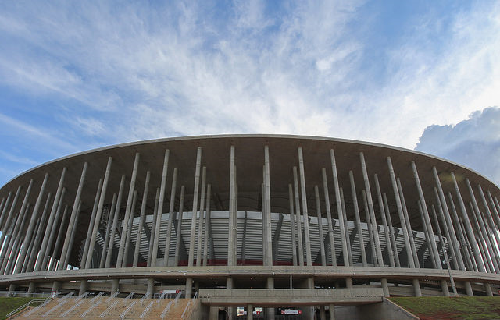White Elephants and the 2014 World Cup Legacy
As required by FIFA regulations, Brazil needed to provide eight stadiums for the 2014 World Cup. However, it was decided to build and renovate an additional four venues in cities spread across the country, adding to the total expenditures of USD 3.6 billion – according to Business Insider. Expenditures raised concerns over the proportionality between utility and costs of the stadiums after the 2014 World Cup.
The World Stadium Index, published by Play the Game and the Danish Institute for Sports Studies in 2014, predicted a low occupancy rate of the stadiums following the 2014 World Cup. All 12 FIFA World Cup venues fall below the average occupancy rate of the 47 stadiums in the index. These predictions are confirmed in a recent survey made by Brazilian newspaper Folha de São Paulo.
According to the survey, the Arena Corinthians in São Paulo is the only stadium with an occupancy rate above 50 percent. At the bottom of the list are the Arena Pantanal in Cuiabá and the Mané Garrincha in Brasilia with an occupancy rate of 13 % and 20 % respectively. The Arena Pantanal hosted a mere 47 matches over a two-year period (2014-2015), equaling one game every 15 days. With construction expenditures exceeding 1 billion reais ($900 million) along with monthly running costs of 125 million reais, the Mané Garrincha in Brasilia is the most expensive of the World Cup venues.
With a surplus of 11 million reais ($3.4 million) in 2014, Arena Corinthians in São Paulo has been the only profitable venue of the 12 World Cup stadiums. The remaining venues have reported large deficits since the 2014 World Cup. Attempts to cover expenses have been made through the hosting of events such as music concerts, automobile exhibitions as well as circuses. The Arena das Dunas in Natal has hosted weddings and children’s birthday parties in the struggle to increase revenue.
The construction of expensive stadiums has led some to question the legacy of the 2016 Olympics in Rio de Janeiro. In 2015, former Minister of Sports, George Hilton, acknowledged the failure of the 2014 World Cup legacy but, referring to the 2016 Olympics, insisted that: "Differently from the World Cup, we are leaving a legacy."
Whether this holds true remains to be seen.
More information:
- Article about stadium occupation rate by Folha de São Paulo
- Read the World Stadium Index annex on Brazilian stadia and predicions of their afteruse: Brazilian World Cup stadiums:A predictable legacy challenge
- Read more about the World Stadium Index
- Reuters article about legacy expectations for the 2016 Olympic games.






